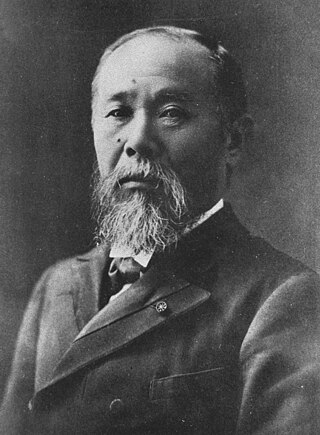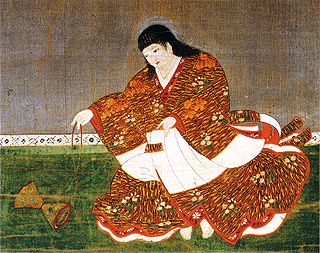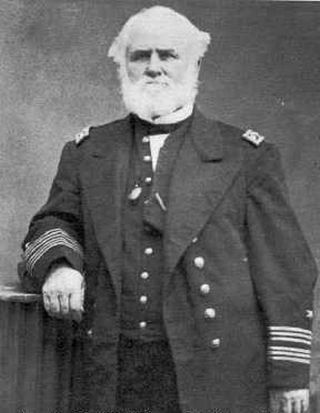Contents
| |||||
| Decades: | |||||
|---|---|---|---|---|---|
| See also: | Other events of 1863 History of Japan • Timeline • Years | ||||
Events from the year 1863 in Japan.
| |||||
| Decades: | |||||
|---|---|---|---|---|---|
| See also: | Other events of 1863 History of Japan • Timeline • Years | ||||
Events from the year 1863 in Japan.

Prince Itō Hirobumi was a Japanese politician and statesman who served as the first Prime Minister of Japan. He was also a leading member of the genrō, a group of senior statesmen that dictated Japanese policy during the Meiji era. He was born as Hayashi Risuke, also known as Hirofumi, Hakubun, and briefly during his youth as Itō Shunsuke.

The Treaty of Shimonoseki, also known as the Treaty of Maguan in China and Treaty of Bakan in the period before and during World War II in Japan, was an unequal treaty signed at the Shunpanrō hotel, Shimonoseki, Japan on April 17, 1895, between the Empire of Japan and Qing China, ending the First Sino-Japanese War.

Osahito, posthumously honored as Emperor Kōmei, was the 121st emperor of Japan, according to the traditional order of succession. Kōmei's reign spanned the years from 1846 through 1867, corresponding to the final years of the Edo period.

Emperor Antoku was the 81st emperor of Japan, according to the traditional order of succession. His reign spanned the years from 1180 through 1185.

Bakumatsu was the final years of the Edo period when the Tokugawa shogunate ended. Between 1853 and 1867, under foreign diplomatic and military pressure, Japan ended its isolationist foreign policy known as sakoku and changed from a feudal Tokugawa shogunate to the modern empire of the Meiji government. The major ideological-political divide during this period was between the pro-imperial nationalists called ishin shishi and the shogunate forces, which included the elite shinsengumi swordsmen.

Takasugi Shinsaku was a samurai from the Chōshū Domain of Japan who contributed significantly to the Meiji Restoration. He used several aliases to hide his activities from the Tokugawa shogunate.

The Shimonoseki campaign was a series of military engagements in 1863 and 1864, fought to control the Shimonoseki Straits of Japan by joint naval forces from the United Kingdom, France, the Netherlands, and the United States, against the Japanese feudal domain of Chōshū, which took place off and on the coast of Shimonoseki, Japan.

Sonnō jōi was a yojijukugo phrase used as the rallying cry and slogan of a political movement in Japan in the 1850s and 1860s, during the Bakumatsu period. Based on Neo-Confucianism and Japanese nativism, the movement sought to overthrow the Tokugawa shogunate and restore the power of the Emperor of Japan.

The Battle of Dan-no-ura was a major sea battle of the Genpei War, occurring at Dan-no-ura, in the Shimonoseki Strait off the southern tip of Honshū. On April 25, 1185, the fleet of the Minamoto clan (Genji), led by Minamoto no Yoshitsune, defeated the fleet of the Taira clan (Heike). The morning rip tide was an advantage for the Taira, but turned to their disadvantage in the afternoon. The young Emperor Antoku was one of those who died among the Taira nobles.

Genji (元治) is a Japanese era name after Bunkyū and before Keiō. This period spanned only slightly more than a single year from March 27, 1864 until May 1, 1865. The reigning emperor was Kōmei-tennō (孝明天皇).

Admiral Sir Augustus Leopold Kuper was a Royal Navy officer known for his commands in East Asia.

David Stockton McDougal was an officer in the United States Navy during the American Civil War most noted for his leadership during a naval battle off of Japan.
Events in the year 1999 in Japan. It corresponds to the year Heisei 11 in the Japanese calendar.

Shimonoseki is a city located in Yamaguchi Prefecture, Japan. As of 30 June 2023, the city had an estimated population of 248,193 in 128762 households and a population density of 350 persons per km2. The total area of the city is 716.18 square kilometres (276.52 sq mi). It is the largest city in Yamaguchi Prefecture and the fifth-largest city in the Chūgoku region in terms of population. It is nicknamed the "Fugu Capital" for the locally caught pufferfish, and is the largest harvester of the pufferfish in Japan.
Events in the year 1992 in Japan. It corresponds to Heisei 4 (平成4年) in the Japanese calendar.

The Order to expel barbarians was an edict issued by the Japanese Emperor Kōmei in 1863 against the Westernization of Japan following the opening of the country by Commodore Matthew Perry in 1854.

The Battle of Shimonoseki Straits was a naval engagement fought on July 16, 1863, by the United States Navy warship USS Wyoming against the powerful daimyō Mōri Takachika of the Chōshū clan based in Shimonoseki.

The Hayabusa is a high-speed Shinkansen service operated by East Japan Railway Company and Hokkaido Railway Company between Tokyo and Shin-Hakodate-Hokuto in Japan since 26 March 2016. The name was formerly used for a limited express sleeping car service operated by JR Kyushu, which ran from Tokyo to Kumamoto, and was discontinued in March 2009.
Events from the year 1864 in France.
Events in the year 1911 in Japan. It corresponds to Meiji 44 (明治44年) in the Japanese calendar.